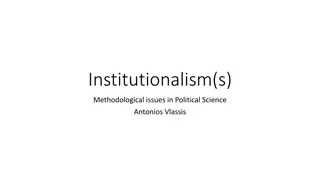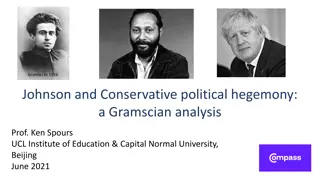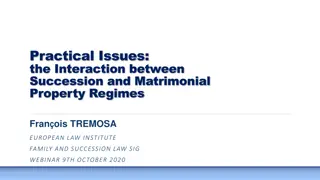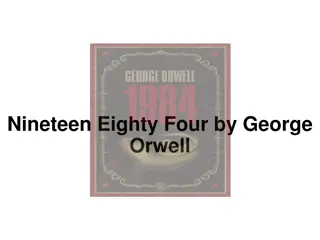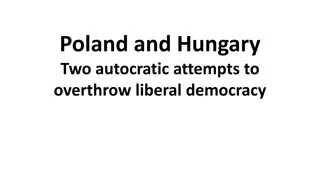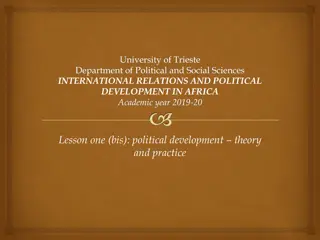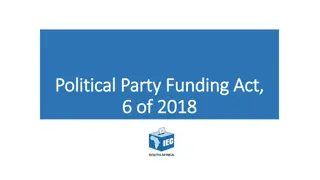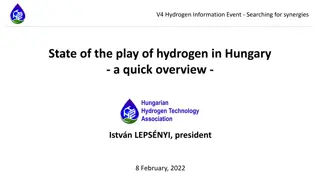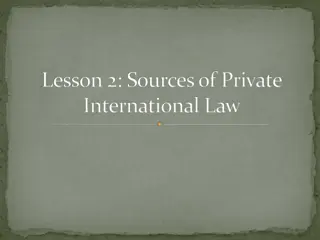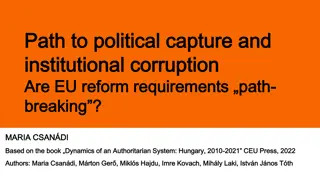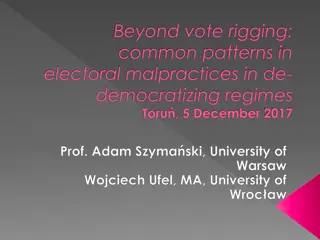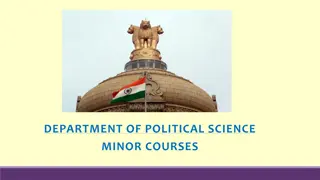Understanding Political Regimes: From Oligarchy to Mafia State in Hungary
Exploring the evolution of political systems in Hungary post-1989, this examination delves into a spectrum of regimes including liberal democracies, dictatorships, and hybrid structures. It analyzes the intricacies of patronage politics and the sociological dimensions that shape the landscape of power and governance.
Download Presentation

Please find below an Image/Link to download the presentation.
The content on the website is provided AS IS for your information and personal use only. It may not be sold, licensed, or shared on other websites without obtaining consent from the author. Download presentation by click this link. If you encounter any issues during the download, it is possible that the publisher has removed the file from their server.
E N D
Presentation Transcript
Oligarchy, State Capture, and the Mafia State: The Curious Case of Hungary B lint Madlovics Central European University 2018.05.09.
Illusions of linear progress towards liberal democracies after the change of the political regimes in 1989-1990; that any regime can be built on any kind of ruins of communist dictatorships. Transitional systems or terminal stations?
Proliferation of political regime categories Liberal democracies Hybrid regimes Dictatorships Representative democracies (consensual or majoritarian): polyarchy participatory democracy deliberative democracy elitist democracy Mixed regimes between democracy and dictatorship: democradura semi-democracy electoral democracy delegative democracy defective democracy illiberal democracy competitive authoritarianism etc. Authoritarian, totalitarian regimes: communist dictatorship closed authoritarianism hegemonic authoritarianism post-totalitarian dictatorship Source: Andr s Boz ki and D niel Heged s, An Externally Constrained Hybrid Regime: Hungary in the European Union, Democratization, April 13, 2018, 1 17.
Adding a Sociological Dimension: A New Interpretative Framework of Post-Communist Regimes Illiberal democracy Communist dictatorship Liberal democracy Patronal democracy Bureaucratic autocracy Patronal autocracy
Patronage Politics: Making Sense of the Sociological Dimension The basis for the term used Alternative terms used for the description of patronage in hybrid regimes 1. Actor network / patronal / clan / mafia state 2. Action rent-seeking / kleptocratic / predatory state 3. Legality corrupt / partially captured / criminal state
Who is the actor? Interpretative layers of categories to describe the mafia state The type of state State Interpretive layers of the category To which features of the state the category refers to Institution by which the ruling elite exercises legitimate coercion The ruling elite s exercising power through mainly informal power network The ruling elite s internal dependency, patron-client relations (patronal power network) The ruling elite s anthropological structure and cultural patterns 1. Monopoly on the right to authorize the legitimate use of violence 1st feature + increasing informal character of the connections within and between the units of the state 1st + 2nd features + the personal, patronal, hierarchically dependent character of the ruling elite 1st + 2nd + 3rd features + the adopted political family (political-economic clan) structure of the ruling elite 1st + 2nd + 3rd + 4th features + the illegal character of the ruling elite s practice of power 2. Network state 3. Patronal state 4. Clan state 5. Mafia state The legality of the ruling elite s actions
What is the action? Interpretative layers of categories to describe the mafia state The type of state Interpretive layers of the category To which features of the state the category refers to Monopoly of taxation (tax, rent, etc.) for maintaing public functions Primary source of state revenues 1. State 1st feature + legal overtaxing in favor of public or private actors Favoritism to expand state bureaucracy for supporters 2. Rent-seeking state 1st + 2nd features + non-legal diverting of current incomes to private hands Illegal favoritism 3. Kleptocratic state 1st + 2nd + 3rd features + expropriation of property using non-legal state coercion Illegal predation 4. Predatory state Internal dimensions: public policy vs. private goals; normative vs. discretional; legal vs. non-legal
Is the action legal? Interpretative layers of categories to describe the mafia state The type of state Interpretive layers of the category To which features of the state the category refers to Monopoly of taxation (tax, rent, etc.) for maintaining public functions Primary source of state revenues 1. State 1st feature + the abuse of entrusted power for private gain (occasional, non- stable chains of vassalage) Corruption = deviant element of the system 2. Corrupt state 1st + 2nd features + chains of corrupt vassalage with a permanent character Corruption = structural element of the system 3. Partially captured state 1st + 2nd + 3rd features + subordinated to and monopolized by a political enterprise (governance led as a criminal organization) Corruption = constituting element of the system 4. Criminal state
Petty corruption Oligarchic state capture High level Political /govern mental actors Low level High level Public admini- stration Low level High level Private sector Low level Legend: Red: demander of corrupt service; Blue: supplier of corrupt service; Green: server of corrupt transaction Continuous line: regular transaction; Dashed line: occasional transaction; Double arrow: voluntary transaction; Single arrow: subordination
Party state capture Criminal state High level Political /govern mental actors Low level High level Public admini- stration Low level High level Private sector Low level Legend: Red: demander of corrupt service; Blue: supplier of corrupt service; Green: server of corrupt transaction Continuous line: regular transaction; Dashed line: occasional transaction; Double arrow: voluntary transaction; Single arrow: subordination
Charasteristics of the Hungarian Post-Communist Mafia-State (10 points)
The distinctiveness of the Mafia State as a subtype of autocracy: 1.) The concentration of political power and the accumulation of personal/family wealth occur in unison. 2.) The Mafia state while coercively extracting personal fortunes constrains or eliminates individual and competitive forms of corruption, and replaces them with ransom levied from above, in a centralized and largely legalized form. 3.) The forced and systematic replacement of the political elite takes place in parallel with that of the economic elite. 4.) The organised underworld s illegal physical coercion, characteristic of the classic mafia, is replaced by bloodless, legalized public authority sponsored coercion.
Share of public procurements without public notice in Hungary between 2009 and 2015 (%) (N =121.849; source: CRCB 2016) 70 60 50 40 30 20 10 0 2009 2010 2011 2012 2013 2014 2015
Corruption risk at the public procurements in Hungary between 2009 and 2015 (N: 118.843; source CRCB 2016) (Corruption risk index: 0 = if there is competition and public notice; 0,5 = if one of them is missing; 1 = if both of them is missing) 0.6 0.55 0.5 0.45 EU Funds Non-EU Funds 0.4 0.35 0.3 0.25 0.2 2009 2010 2011 2012 2013 2014 2015
The change of overpricing in Hungarian public procurements between 2009 and 2015(N = 123,224; source: CRCB 2016) 8 7 6 5 4 3 2 1 0 2009 2010 2011 2012 2013 2014 2015 (The mean squared error (MSE) of contract prices of Hungarian Public Procurements from the theoretical (Benford s) distribution by year, first digits, 2009-2015, N = 123,224)
5.) The practice of nationalization in the mafia state: reiderstvo or transit nationalization Strength of the state Legiti- macy of raiding The initiator or client of the corporate raiding Organized upperworld: chief patron (top level public authority) Low or middle level public authority Rival entrepreneurs or oligarchs Organized underworld: criminal groups XXXXXXXXXXXXXXXXX XXXXXXXXXXXXXXXXX XXXXXXXXXXXXXXXXX White raiding Strong state I I I I Weak state XXXXXXXXXXXXXXXXX XXXXXXXXXXXXXXXXX XXXXXXXXXXXXXXXXX XXXXXXXXXXXXXXXXX XXXXXXXXXXXXXXXXX XXXXXXXXXXXXXXXXX Gray raiding XXXXXXXXXXXXXXX XXXXXXXXXXXXXXXXX XXXXXXXXXXXXXXX XXXXXXXXXXXXXXX XXXXXXXXXXXXXXX Crime Black raiding Criminal state Single-pyramid patronal system Monopolized Oligarch capture State crime Corporate crime Multi-pyramid patronal system Institutional environment and features of the raiding action Oligarchic Competitive n.a. Partial state capture
Hungarian examples for white raiding Action by the criminal state ESMA (outdoor advertising company) Land leases of state lands Slot machines, casinos, online gambling Tobacco retail concessions private sector private + public sector private + public sector private sector injured party multi-staged multi-staged multi-staged multi-staged connectedness interinstitutional (horizontal and vertical) interinstitutional (horizontal and vertical) interinstitutional (horizontal) inter-institutional (horizontal and vertical) institutional scope nationwide local and nationwide nationwide local and nationwide extent of the authority of the collaborating inst.s legislative, executive branches (ministries, tax authority) legislative, executive branches (ministries, National Land Fund Management Org.) legislative, executive branches (ministries) legislative, executive branches type of collaborating institutions according to their branch of power extortion, abuse of authority, abuse of a public service position, buying influence, bribery of officials (active and passive) buying influence, racketeering, bribery of officials (active and passive) buying influence, racketeering, bribery of officials (active and passive) abuse of authority, abuse of a public service position, racketeering, bribery of officials (active and passive) applicable statutory definition of crime
6.) Single pyramid patronal network: key players and the separation of branches of power Executive power Party background Economic power Media power Personal wealth Chief patron + + + + + Poligarch (1) + - + - - + Poligarch (2) - + + - - + Oligarch (1) + - - + - + Oligarch (2) + - - - + + Front man (political) - + - - - Front man (economic) - - - - +
7.) Decisions are taken outside the competence of formalized and legitimate organizations. Informal power network. It is not the model of the communist parties politburo , but the chief patron s court run by the adopted political family. 8.) Patronal servants: the takeover of the leading positions of administration is not done by party commissars , who are loyal to the party, but by clients who are loyal to the chief patron, to the head of the adopted political family through personal links. The party is a transmission belt of the patronal network. The Mafia state is not ideology driven, but ideology applying.
9.) Public interest is systematically subverted to private interest; decisions concern power concentration and the wealth of the adopted political family at the same time. The rule of law is substituted by the law of rule . Custom-tailored parliament and selective law-enforcement. 10.) The Mafia state is compelled to bridge the gap between the sociological nature and legality of autocratic rule with quasi- democratic procedures by restricting civil rights and electoral rules. It is neither a liberal democracy, nor a dictatorship based purely on coercion.
Modelled Trajectories of Post-Communist Regimes: 1. Hungary Illiberal democracy Communist dictatorship Liberal democracy 1990-1998 Patronal democracy Bureaucratic autocracy Patronal autocracy
Modelled Trajectories of Post-Communist Regimes: 2. Poland Illiberal democracy 1990-2015 Communist dictatorship Liberal democracy 2015- Patronal democracy Bureaucratic autocracy Patronal autocracy
Modelled Trajectories of Post-Communist Regimes: 3. Romania Illiberal democracy Communist dictatorship Liberal democracy Patronal democracy Bureaucratic autocracy Patronal autocracy
Modelled Trajectories of Post-Communist Regimes: 4. Ukraine Illiberal democracy Communist dictatorship Liberal democracy Patronal democracy Bureaucratic autocracy Patronal autocracy
Modelled Trajectories of Post-Communist Regimes: 5. Russia Illiberal democracy Communist dictatorship Liberal democracy Patronal democracy Bureaucratic autocracy Patronal autocracy
Modelled Trajectories of Post-Communist Regimes: 6. Uzbekistan Illiberal democracy Communist dictatorship Liberal democracy Patronal democracy Bureaucratic autocracy Patronal autocracy
Modelled Trajectories of Post-Communist Regimes: 7. China Illiberal democracy Communist dictatorship Liberal democracy Patronal democracy Bureaucratic autocracy Patronal autocracy



